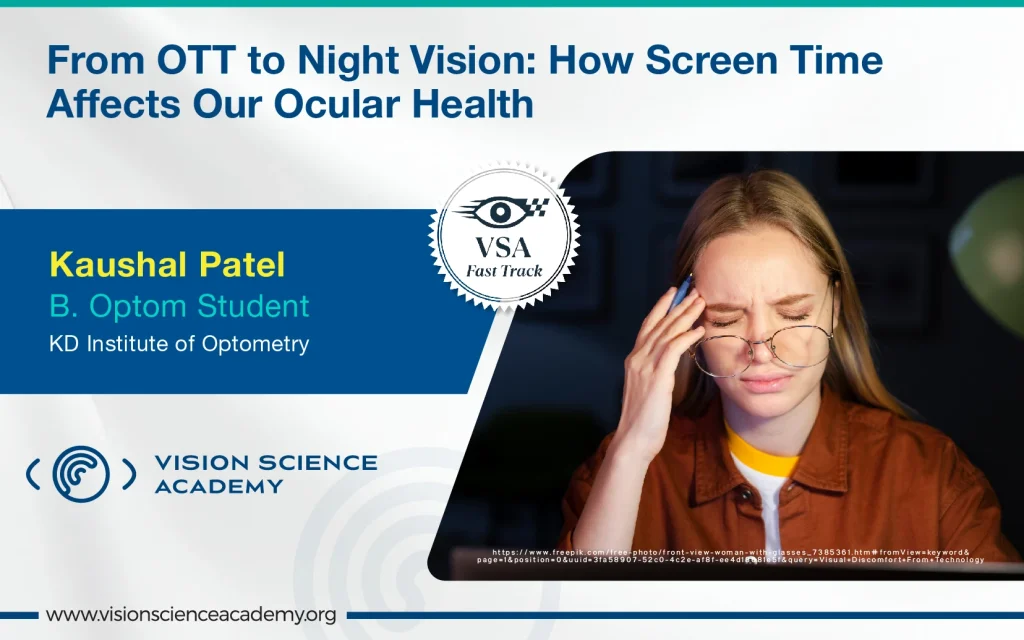Kaushal Patel,
B. Optom Student, KD Institute of Optometry, Ahmedabad, India
The digital era has transformed how we live, learn, and interact. Daily screen use, whether for education, employment, or entertainment, has increased dramatically, particularly among teens and young people. A population-based survey in Brazil of 200 participants aged 12-35 years indicated that 75.5% of people reported screen use exceeding 5 hours per day, with a significant prevalence of refractive problems such as myopia (84%) and astigmatism (75.5%). (1) The study also found ocular symptoms such as dryness, grittiness, redness, visual tiredness, and blurred vision, with some subjects being unaware of their pre-existing eye diseases. Interestingly, a fraction of respondents demonstrated behavioural changes such as smartphone addiction and communication difficulties, implying that digital exposure has psychosocial consequences. (1–4)
Digital Eye Strain and Myopia: A Growing Visual Health Concern
Digital Eye Strain (DES), also known as Computer Vision Syndrome, is a multifactorial illness that causes headaches, eye tiredness, neck pain, and blurred vision. (2) Environmental issues such as inadequate lighting, glare, and poor ergonomics exacerbate these impacts. The COVID-19 pandemic exacerbated DES, particularly in youngsters, resulting in significant difficulties as new-onset esotropia, vergence dysfunction, and accelerated myopia progression. (3)
Meta-analyses have found a strong correlation between screen use and rising myopia rates. According to one study of 19 research, youngsters who spent more time on screens were 2.24-2.39 times more likely to acquire myopia. (4) Each extra hour of screen time raised risk by 7%, with computers posing the highest harm (OR = 8.19), followed by TVs and then smartphones most likely due to characteristics such as text size, viewing distance, and visual demand. These findings highlight the critical necessity for preventative ergonomics and visual health measures.
Figure 1: The impact of excessive screen time at night
Ocular Discomfort and Cognitive-Behavioural Impact
Extended use of screens has effects on mental health in addition to eye health. According to the Brazilian study, prolonged use of devices is linked to increasing symptoms of emotional dysregulation and digital dependence. (1) This demonstrates how brain adaptation, psychological health, and visual ergonomics are all intertwined in the digital age.
| Domain | Effects |
|---|---|
| Visual Health | Myopia, Astigmatism, Dryness, Redness, Blurred Vision |
| Musculoskeletal | Neck pain, Shoulder strain, Headaches |
| Behavioural | Smartphone addiction, Communication difficulties |
| Cognitive | Visual fatigue, Decreased attention, Mental fatigue |
| Public Health Risk | Unawareness of refractive errors, Increased sedentary lifestyle, Myopia boom |
Table 1: Screen Exposure and Its Multidimensional Impact
Evidence-Based Interventions: Mitigating the Impact
Individualised and proactive care is necessary for the treatment of DES and screen-associated myopia: (5)
- To reduce accommodating stress, follow the 20-20-20 guideline.
- To avoid tear film instability, promote regular blinking.
- Adjust eye level and screen distance (40–70 cm) as needed.
- Make use of ergonomic lighting, anti-reflective coatings, and blue light blocking lenses.
- Encourage outdoor activities, which offer organic visual stimulation to offset the predominance of screen time near work.
New developments like built-in filters, high-resolution matte screens, and specially made lens designs for spectacles present encouraging supplements to behavioural changes.
Conclusion: A Vision for the Digital Generation
Clinicians, researchers, and legislators must give the ocular consequences of screen time immediate consideration as it has become an unavoidable part of modern life. These days, screen-induced myopia, accommodative dysfunction, and digital eye strain are all components of a broader public health issue. (2–4) A multidisciplinary strategy combining optometric treatment, ergonomics, technology design, and public awareness is needed to address issues. Instead of shunning screens, let us learn to use them more wisely and safely so that our eyes can continue to function well, whether we are watching Over-The-Top (OTT) for hours on end or using night vision.
References
- Barros VFDS, De Oliveira RADSG, Maia RB, Fernandes N, Almodin EM. Effects of the excessive use of electronic screens on vision and emotional state. Rev Bras Oftalmol. 2021;80(5):1–6.
- Pavel IA, Bogdanici CM, Donica VC, Anton N, Savu B, Chiriac CP, et al. Computer Vision Syndrome: An Ophthalmic Pathology of the Modern Era. Vol. 59, Medicina (Lithuania). MDPI; 2023.
- Kaur K, Gurnani B, Nayak S, Deori N, Kaur S, Jethani J, et al. Digital Eye Strain- A Comprehensive Review. Vol. 11, Ophthalmology and Therapy. Adis; 2022. p. 1655–80.
- Zong Z, Zhang Y, Qiao J, Tian Y, Xu S. The association between screen time exposure and myopia in children and adolescents: a meta-analysis. BMC Public Health. 2024 Dec 1;24(1).
- Coles-Brennan C, Sulley A, Young G. Management of digital eye strain. Vol. 102, Clinical and Experimental Optometry. Blackwell Publishing Ltd; 2019. p. 18–29.
